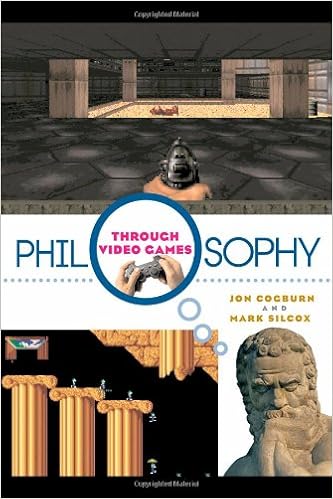
By Daniel Albright
Albright explores how various media have interaction, as in a drama, whilst speech, level decor, and tune are co-present, or in a musical composition that employs the university approach to the visible arts. Tracing arguments and questions about the family one of the arts from Aristotle’s Poetics to the current day, he illuminates the understudied self-discipline of comparative arts and urges new consciousness to its riches.
Read or Download Panaesthetics: On the Unity and Diversity of the Arts (The Anthony Hecht Lectures in the Humanities Series) PDF
Similar Aesthetics books
Philosophy Through Video Games
How can Wii activities educate us approximately metaphysics? Can enjoying global of Warcraft bring about better self-consciousness? How will we find out about aesthetics, ethics and divine attributes fromZork, Grand robbery vehicle, and Civilization? numerous more and more refined games are swiftly overtaking books, movies, and tv as America's hottest kind of media leisure.
Psychoanalyzing Cinema: A Productive Encounter with Lacan, Deleuze, and Zizek
The essays inside this assortment discover the probabilities and possibilities of all 3 positions, featuring encounters which are, from time to time contradictory, at different occasions supportive, in addition to complementary. the gathering thereby enriches the questions which are being raised inside of modern cinematic reports.
A massive new interpretation of the philosophical value of the oeuvre of Denis Diderot. Dramatic Experiments offers a entire learn of Denis Diderot, one of many key figures of ecu modernity. Diderot used to be a French Enlightenment thinker, dramatist, paintings critic, and editor of the 1st significant glossy encyclopedia.
Highlights Merleau-Ponty’s curiosity in movie and connects it to his aesthetic concept. within the Flesh of pictures, Mauro Carbone starts with the purpose that Merleau-Ponty’s frequently misunderstood suggestion of “flesh” was once in a different way to suggest what he often known as “Visibility. ” contemplating imaginative and prescient as inventive voyance, within the visionary feel of making as a selected presence anything which, as such, had now not been current prior to, Carbone proposes unique connections among Merleau-Ponty and Paul Gauguin, and articulates his personal additional improvement of the “new inspiration of sunshine” that the French thinker used to be starting to difficult on the time of his unexpected demise.
Additional resources for Panaesthetics: On the Unity and Diversity of the Arts (The Anthony Hecht Lectures in the Humanities Series)
The Speech of Cinema work might suggest strength and movement, but if the futurists have been portray, they have been competing with photographs that truly moved. The cinema additionally has its languages, to a point made up our minds by means of a unmarried variable: the size of the take. a movie shot with lengthy takes, corresponding to Alfred Hitchcock’s Rope (1948), edited to appear like one non-stop take, or Alexander Sokurov’s preposterously virtuosic Russian Ark (2002), which obviously is one non-stop take, offers a powerful impact of imitating the sphere of imaginative and prescient of a unmarried human eyeball. The motion picture develops that means via our quit (or failure to give up) to the camera’s chasing after or taking flight from the gadgets of its interest: its boldness or timorousness defines a subject-position, even if we all know not anything concerning the camera’s “character” except its means of relocating via its setting. The first-person shooter of games allows the participant to take cost of the lengthy take (demands it, in fact): that the shooter can occasionally see his or her personal arm preserving the pistol intensifies the kinesthetic identity of participant and avatar. yet even within the cinema, the lengthy take regularly creates an avatar that we play with and that performs with us. so much modern administrators appear to dislike lengthy takes other than lower than strange situations, and so they frequently cut up static scenes, no longer with any specific motive of montage, yet just to deny the digital camera its personal standpoint, its personal character. v114f What Is portray? Cinema, in fact, was once initially silent, and needed to create its languages via pictorial ability, occasionally with a bit aid from an accompanying pianist. And in a feeling the proper protagonist of a silent motion picture is mute or approximately mute—someone whose expressive strength lies in gestural depth, reminiscent of Quasimodo as performed via Lon Chaney within the Hunchback of Notre Dame (1923) or the somnambulist killer Cesare within the cupboard of Dr. Caligari (1920). After sound did come to video clips, in 1927, nonspeaking characters have been frequently nonetheless sought after, as though a definite feel continued that cinema was once, on the middle of its being, silent: the monster performed by means of Boris Karloff in Frankenstein (1931), for instance, or the ape in King Kong (1933) or Harpo in any of the Marx Brothers motion pictures. almost all these characters are figures of horror, as though the cinematic elegant, its middle astonishment, arises from the refusal of the natural photograph to make articulate sound: the language of cinema turns out so much fluently spoken through photos, simply photos. one of many first vital videos, the Lumière brothers’ the arriving of a teach at los angeles Ciotat Station (1896), prompted panic within the viewers based on a reporter for Der Spiegel, for the teach appeared approximately to run from the display into the theater: an weigh down by way of in simple terms visible capability. perhaps the director such a lot delicate to distinction of cinema-dialect among silent and conversing video clips was once Charlie Chaplin. His glossy instances (1936) has a soundtrack, with the standard volume of historical past tune.



